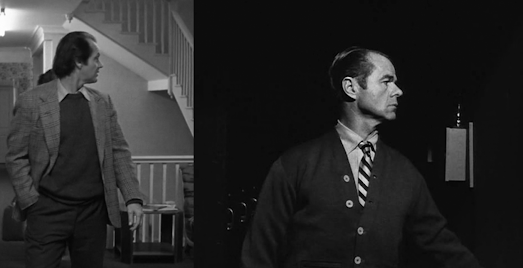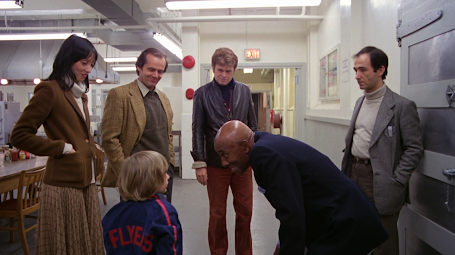Jack Torrance (Jack Nicholson) and George Peatty (Elisha Cook) share a similar physical appearance - that is to say, Nicholson and Cook share a similar appearance. George suspects he is being cuckolded by Sherry (Marie Windsor) in The Killing while Jack feels unappreciated, for lack of a better word, in The Shining. George, we can imagine, is resentful of Sherry, though he doesn't show it. Jack, on the other hand, is completely animated. And yet, from what we see, Wendy is a good person while Sherry is selfish and unfaithful, joking about the meal she hasn't cooked for tired George at the end of his work-day. Jack freezes to death in the maze, while George is shot in the altercation where he is the lone survivor, only to die later, before a cold, impersonal Sherry. Wendy survives, in spite (or because) of Jack, just as Sherry survives in spite (or because) of George. But Jack and George die foolish deaths; is cool, calm George any more intelligent or moral than Jack? Arguably not.
It is strongly implied that Sherry sleeps with Val, so George's suspicions are likely correct. Johnny mentions to the existing group that two more men are going to join their race-track heist. The group are worried about the two men Johnny mentions: they are right to be worried, though they do not yet know the dangers that await them. The two additional men who do step in to help are little more than pawns: one, Nikki, gets shot, and the other, Maurice, goes to prison. The two men, Val (Vince Edwards) and Tiny (Joe Turkel), Johnny doesn't know are planning a heist of their heist, also die tragically. Val is arguably a pawn for Sherry, while Tiny is a pawn for Val.
But I'll have to get into all that another time. The physical similarities between Elisha Cook and Jack Nicholson have been noted before. As characters, as I've stated above, Jack and George both fail after much suffering.
Consider Jack (left) looking over his shoulder at two women departing the Overlook. Note this image was reversed and made black-and-white. Jack would have been looking over his right shoulder at the two women in The Shining. George enters a door in the locker room before just the race-track heist goes down. Both wear formal attire including a button-down shirt and sweater. Both hairlines are similar and receding; their facial features are sharp and thin, and suggest Anglo-Saxon heritage.
This side-by-side is slightly more interesting - George (top) cocks his head right, as if listening to the sounds from outside the window, shortly before the meta-robbers, Val and Tiny, break down the doors, guns in hand. Jack's gaze falls in the mirror, not at Grady. Grady + Jack + Jack's mirror image = 3. George is "reflected" or "betrayed" in the image of Val and Tiny. In this way, Val and Tiny are almost imaginary allies or friends of George. Still, Jack and George are solitary figures, and their physical and narrative "twinning," as actors and characters, is uncanny.












































